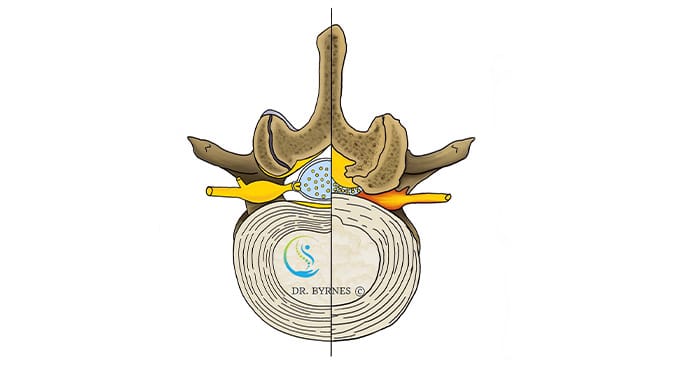
Spinal stenosis is a condition in which the central vertebral canal through which the lumbar nerve and Cauda Equina pass, is narrowed.
This narrowing is usually due to a combination of degenerative processes including;
Symptoms commonly described include back and leg pain when standing upright or walking. Associated sensory disturbance is not infrequent. These neurological lower limb symptoms that are precipitated by walking are termed Neurogenic Claudication.
Stenosis can develop in the Cervical, Throacic or Lumbar regions of the spine. It most frequently develops in the lumbar area. Ageing generally results in a relative narrowing of the spinal canal however not everyone will develop severe enough to cause symptoms.
Symptoms usually develop progressively over time but may occur or deteriorate suddenly. In general patients complain of back and usually bilateral radiating leg pain and heaviness when standing or walking for a period of time. There can be sensory disturbance or frank numbness in the legs and often the soles of the feet. The symptoms are often relieved by sitting or simply leaning forward on something such as furniture or a shopping trolley for support.
Leg pain can also develop in the legs of patients with poor lower limb blood supply. The symptoms of this vascular claudication are often noticeably worse when walking up hill and are not so easily relieved by bending. There are usually identifiable signs of poor blood supply in the lower limbs which allow these patients to be identified.
If you experience extreme leg weakness (foot drop) or difficulty controlling your bladder or bowel function, seek medical help immediately. This is a sign of cauda equina syndrome.
Progressive age-related degeneration and osteoarthritis of the spine result in bulging discs, enlarging facet joints, the development of arthritic bony spurs and thickening of the spinal ligaments. These changes encroach upon the spinal canal, narrowing it and leading to stenosis.
Lumbar Canal Stenosis is most common between the ages of 50 and 70. It has a tendency to occur earlier in those who are born with a narrow spinal canal.
A careful medical exam will attempt to determine the type and cause of your spine problem and the treatment options. A diagnostic evaluation includes a medical history and physical exam. Often imaging scans (e.g., x-ray, CT, MRI) and tests to check muscle strength and reflexes are used.
Doppler ultrasound uses sound waves to assess blood flow. This test may be requested to rule out peripheral artery disease as a cause of the claudication.
